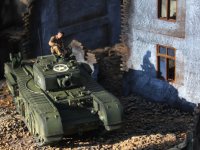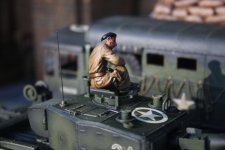Excerpt from:
https://tankmuseum.org/article/tanks-dday
In 1943, Hobart was tasked with raising and training the 79th Armoured Division. The division was unusual in that it never actually fought as a division but was a holding formation for specialised vehicles, which were then “lent” to other formations on a mission specific basis. Hobart was in his element, applying huge energy and an ability to “think outside the box” to solve the massive problems of an opposed beach landing.

K&C Hobart figure on the left.
The 79th Armoured rapidly became a collection of some of the oddest AFVs ever to see service on a battlefield. Most were based on either the American M4 Sherman or the British Churchill tank. The Sherman was reliable and available in numbers, and the Churchill was heavily armoured with good cross-country and climbing capability.
The most versatile of the Funnies was the AVRE – Assault Vehicle Royal Engineers. Based on a Churchill,

K&C Churchill.
.... the AVRE retained the hull, turret, and mechanics of the tank but was adapted in a number of ways. Firstly, the Churchill interior was stripped out to allow the stowage of engineer stores.
The Churchill’s main gun was then replaced with a weapon called a Petard, a 29mm Spigot Mortar. The spigot part of the weapon was a hollow tube over which the tail of a drum shaped projectile was fitted. Called the Flying Dustbin, the tail contained a propellant charge, which would send the projectile and its 18kg explosive charge up to 140m.
This was effective against obstacles and fortifications, but it did have a significant disadvantage from the crew perspective in that it had to be reloaded from the outside via a hatch on the foredeck – not the healthiest occupation in combat!

Figarti AVRE with Petard Mortar

The AVRE was also equipped to carry and deploy a range of other pieces of equipment, including the Bobbin, a 3m wide reel of canvas reinforced with steel rods that could be laid as a trackway across soft mud or sand, a Small Box Girder Bridge, capable of spanning a 30ft gap; double onion demolition charges attached to a steel frame or a brushwood; and timber fascine, which could be dropped into something like an anti-tank ditch to enable crossing.
The AVRE had a crew of six; five Royal Engineer specialists and a driver from the Royal Armoured Corps. Apart from the range of equipment the AVRE was equipped with, the onboard stores included demolition charges, which the Sappers could deploy using the Churchill’s convenient sponson doors.
https://www.iwm.org.uk/history/the-funny-tanks-of-d-day
https://www.rememuseum.org.uk/Blog/reme-history-the-crab
Sherman Crabs were used on D-Day to clear mines. The rotating drum would flail the minefield with the attached chains, clearing a path. Converted flail Matildas were successfully used earlier at El Alamein.
I don't know if anyone made a Sherman Crab model, this mine clearance version of a Churchill Flail tank is by Figarti (not sure how historically accurate this is but I really like the model).







 K&C Hobart figure on the left.
K&C Hobart figure on the left. K&C Churchill.
K&C Churchill.



